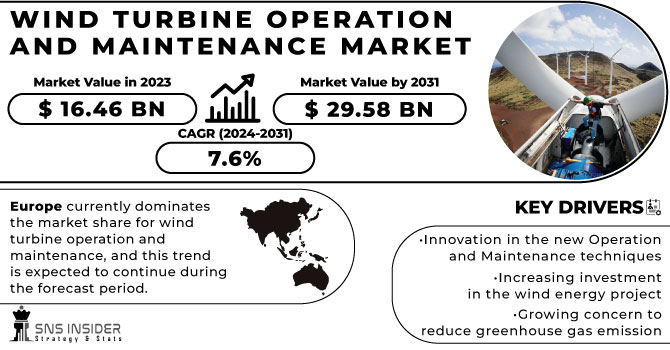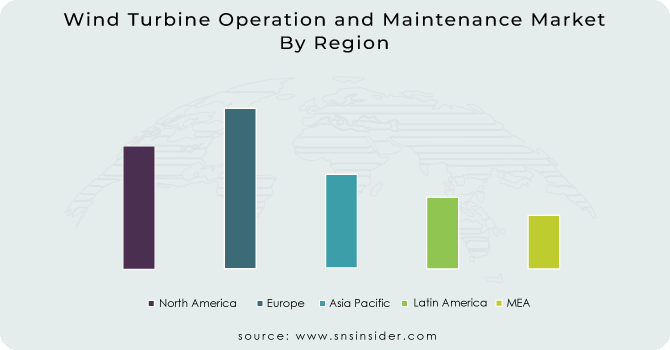Wind Turbine Operation and Maintenance Market Report Scope & Overview:
The Wind Turbine Operation and Maintenance Market size was valued at USD 16.46 billion in 2023 and is expected to grow to USD 29.58 billion by 2031 and grow at a CAGR of 7.6% over the forecast period of 2024-2031.
The operation and maintenance of wind turbines are crucial for the efficient and effective generation of renewable energy. Wind turbines are complex machines that require regular maintenance to ensure optimal performance and longevity. To operate a wind turbine, the blades must be positioned to face the wind, and the rotor must be connected to the generator. The generator then converts the kinetic energy of the wind into electrical energy, which is then transmitted to the power grid.

To Get More Information on Wind Turbine Operation and Maintenance Market - Request Sample Report
Regular maintenance is necessary to ensure that the wind turbine operates at peak efficiency. This includes inspecting and repairing any damage to the blades, checking the gearbox and bearings for wear and tear, and monitoring the electrical components for any signs of malfunction. In addition to regular maintenance, wind turbine operators must also be prepared to handle unexpected issues that may arise. This requires a thorough understanding of the turbine's components and the ability to troubleshoot and repair any problems quickly and efficiently. The market for wind turbine operation and maintenance is a rapidly growing industry. As the demand for renewable energy sources continues to increase, the need for efficient and reliable wind turbines becomes more important than ever before.
Market Dynamics:
Drivers
-
Innovation in the new Operation and Maintenance techniques
-
Increasing investment in the wind energy project
-
Growing concern to reduce greenhouse gas emission
-
Increasing need for cost-effective tools for the maintenance of wind turbines
The increasing need to decrease greenhouse gas emissions is the primary driving force behind the Wind Turbine Operation and Maintenance market. As the world becomes more aware of the negative impact of carbon emissions on the environment, there is a growing demand for renewable energy sources such as wind power. This has led to a surge in the installation of wind turbines, which require regular maintenance and upkeep to ensure optimal performance. As a result, the Wind Turbine Operation and Maintenance market has become a crucial component of the renewable energy industry.
Restrain
-
High cost associated with the maintenance and service of the wind turbines
-
Fluctuation in the raw material prices
Opportunities
-
Increasing adoption of renewable energy sources
-
Rising number of wind power installations across the world
Challenges
-
Increasing competition for wind turbine operation and maintenance market
-
Fluctuation in the wind speed and direction
The variability of wind resources poses a significant challenge for the Wind Turbine Operation and Maintenance Market. This industry relies heavily on consistent and reliable wind patterns to generate energy efficiently. However, the unpredictable nature of wind can lead to fluctuations in power output and increased wear and tear on equipment. As a result, companies in this market must constantly adapt and innovate to overcome these obstacles and ensure the long-term sustainability of their operations. Despite these challenges, the Wind Turbine Operation and Maintenance Market remains a critical player in the global shift toward renewable energy sources.
Impact of COVID-19:
The COVID-19 pandemic affected the wind turbine operation and maintenance market significantly. The global lockdowns and travel restrictions have disrupted the supply chain and caused delays in the delivery of spare parts and equipment. This has resulted in a decrease in the efficiency of wind turbines and an increase in maintenance costs. Furthermore, the pandemic has led to a decrease in demand for electricity, which has affected the profitability of wind energy projects. Many countries have reduced their energy consumption due to the closure of businesses and industries, resulting in a decrease in the demand for electricity. This has led to a decrease in the revenue generated by wind energy projects, making it difficult for operators to cover their operation and maintenance costs.
Impact of Russia-Ukraine War:
The ongoing conflict between Russia and Ukraine has significantly impacted various industries, including the wind turbine operation and maintenance market. The war has disrupted the supply chain of wind turbine components, leading to delays in maintenance and repairs. This has resulted in decreased efficiency and increased downtime for wind turbines, ultimately affecting the industry’s overall profitability. The detailed analysis is included in the final report.
Impact of Recession:
The recession has had a significant impact on the wind turbine operation and maintenance market. The recession has caused a decrease in demand for renewable energy, which has led to a decrease in the need for wind turbine operation and maintenance services. As a result, many companies in the wind turbine operation and maintenance market have been forced to downsize. This has led to a decrease in the number of jobs available in this industry, which has had a ripple effect on the economy as a whole. The detailed analysis is included in the final report.
Key Market Segmentation
By Type:
-
Scheduled
-
Unscheduled
By Application:
-
Onshore
-
Offshore
Regional Analysis
Europe currently dominates the market share for wind turbine operation and maintenance, and this trend is expected to continue during the forecast period. This growth can be attributed to the presence of a higher number of offshore wind farms in countries such as the UK, Germany, Denmark, and the Netherlands. The United Kingdom boasts the highest number of offshore wind turbines. For instance, At the end of 2020, Europe had a total of 25,014 MW installed, with 116 wind farms across 12 European countries, including sites with partial grid connections. Impressively, 5,402 turbines are connected to the grid.
During the forecast period, the Asia Pacific region is projected to experience the highest Compound Annual Growth Rate (CAGR) due to the government's increasing investment in renewable energy infrastructure. The installation of wind turbines in China, India, and other emerging countries has seen remarkable growth, driven by the rising population and industrialization, which has led to an increasing need for energy. Furthermore, governments in the region are taking the initiative to curb carbon emissions, which has further fueled the need for renewable energy resources. This has ultimately propelled the growth of the wind turbine operation and maintenance market.

Do You Need any Customization Research on Wind Turbine Operation and Maintenance Market - Enquire Now
REGIONAL COVERAGE:
-
North America
-
USA
-
Canada
-
Mexico
-
-
Europe
-
Germany
-
UK
-
France
-
Italy
-
Spain
-
The Netherlands
-
Rest of Europe
-
-
Asia-Pacific
-
Japan
-
South Korea
-
China
-
India
-
Australia
-
Rest of Asia-Pacific
-
-
The Middle East & Africa
-
Israel
-
UAE
-
South Africa
-
Rest of the Middle East & Africa
-
-
Latin America
-
Brazil
-
Argentina
-
Rest of Latin America
-
Key Players
The major players are GE, Siemens Gamesa, Vestas, NORDEX SE, Deutsche Windtechnik, Suzlon Energy Limited, Enercon GmbH, B9 Energy Group, Fred. Olsen Windcarrier, GoldWind, REETEC and other Players
GE-Company Financial Analysis

| Report Attributes | Details |
| Market Size in 2023 | US$ 16.46 Bn |
| Market Size by 2031 | US$ 29.58 Bn |
| CAGR | CAGR of 7.6% From 2024 to 2031 |
| Base Year | 2023 |
| Forecast Period | 2024-2031 |
| Historical Data | 2020-2022 |
| Report Scope & Coverage | Market Size, Segments Analysis, Competitive Landscape, Regional Analysis, DROC & SWOT Analysis, Forecast Outlook |
| Key Segments | • By Type (Scheduled and Unscheduled) • By Application (Onshore and Offshore) |
| Regional Analysis/Coverage | North America (USA, Canada, Mexico), Europe (Germany, UK, France, Italy, Spain, Netherlands, Rest of Europe), Asia-Pacific (Japan, South Korea, China, India, Australia, Rest of Asia-Pacific), The Middle East & Africa (Israel, UAE, South Africa, Rest of Middle East & Africa), Latin America (Brazil, Argentina, Rest of Latin America) |
| Company Profiles | GE, Siemens Gamesa, Vestas, NORDEX SE, Deutsche Windtechnik, Suzlon Energy Limited, Enercon GmbH, B9 Energy Group, Fred. Olsen Windcarrier, GoldWind, and REETEC. |
| Key Drivers | • Innovation in the new Operation and Maintenance techniques • Increasing investment in the wind energy project |
| Market Opportunities | • Increasing adoption of renewable energy sources • Rising number of wind power installations across the world |

